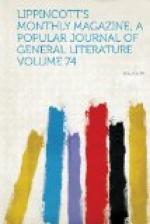When Mrs. and Mrs Ormiston returned they found that their eldest daughter was engaged to be married, which surprised them as little as it did the old woman but moved them a good deal more.
THE LEADEN ARROW.
A wondrous half-century was that which forms an isthmus rather than a bridge between the Middle Ages and the times termed Modern. Exit the Last of the Barons—enter the printing-press. Exit Boabdil el Chico—enter Columbus and Da Gama. The plot thickened as the cinquecenti hove in view. The last years were the most pregnant. While the last sigh of the Moor was dying into the murmurs of the Xenil, that solitary shout that will ring while earth lasts went up from the bows of the Pinta. Together came America and the sea-way to India and—the rifle. For in 1498, when Buonarotti was at his prime, Raphael, fifteen years old, had just taken his seat at the paternal easel, and the scenes of the Lusiad were in progress, “barrels were first grooved at Venice.”
Who grooved them we are not told. The name of that artist has not survived, though we still remember his contemporary townsman, Titian. Strictly, he is not entitled to the immortality of an originator. That belongs to the unknown savage who, in the miocene era probably, first gave a twist to the feather of his arrow, thereby communicating to it a revolving motion at right angles to the line of flight, and making it an “arm of precision.” But pre-historic artillery we may dismiss or leave to Milton. The blind bard omits to inform us whether the guns used in the great pounding-match between Lucifer and Michael were smooth-bores or rifles. The strong presumption is that they were exclusively the former, and that a well-served battery of Parrotts would have silenced them in fifteen minutes. By giving him a few pieces of the kind the poet would have further brightened the feather he sets in Satan’s cap as the benefactor of mankind by inventing gunpowder and shortening wars. The bow he presents to us as an old and familiar weapon even at the date of that first and greatest of pitched battles. Its claim, as the parent of projectile implements, is recognized in the common etymology of arcus, arcualia—artillery. Arblast, arquebuse, blunderbuss, mark a humbler collateral descent in the same verbal family. The ballista, or fifty-man-power bow, constituted the heavy, and the individual article the light, artillery of twenty centuries ago. Slings and javelins, being for hand-to-hand fighting (David was near enough to hold an easy conversation with Goliath before bringing him down), can hardly be brought within the designation. The twang of either heavy or light was but a thin contribution to the orchestra of battle compared to “the diapason of the cannonade.” How much we have lost in the absence of this element of tremendous noise from the conflicts of ancient days! What a tool it would have been in Homer’s hands!




